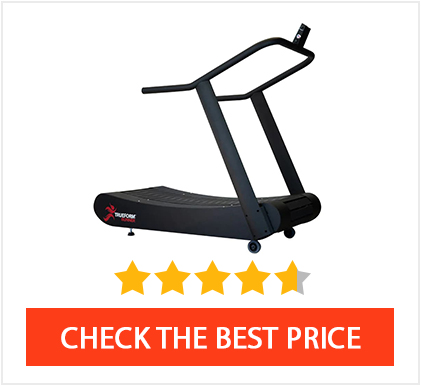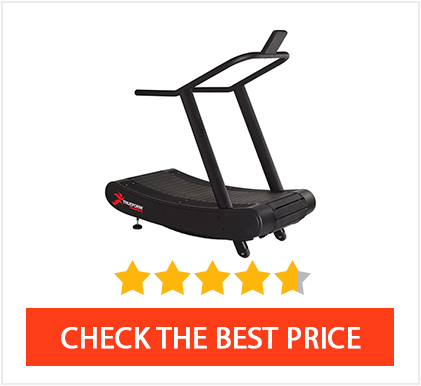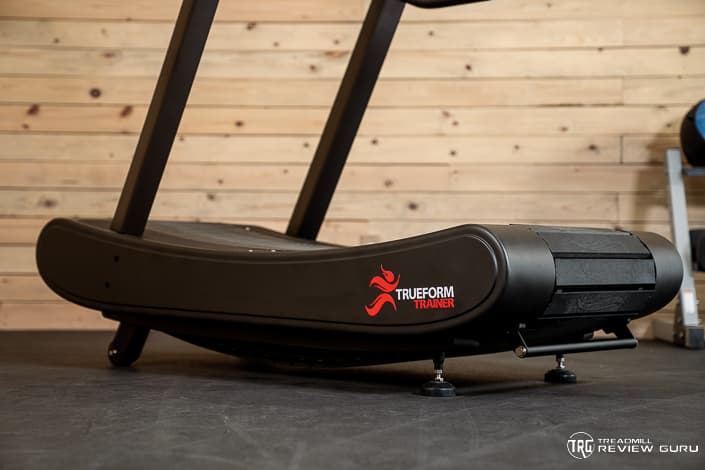*TreadmillReviewGuru helps consumers find the best home fitness products. When you buy a product we recommend, we may earn a commission.
Last Updated: June 29, 2023
TrueForm is known for its curved, manual treadmills which are some of the best manual treadmills on the market, in our opinion. Found in homes, commercial gyms, and sports facilities, TrueForm Treadmills are excellent training tools to help encourage proper form while running. In this comparison review, we’ll go over how the premium TrueForm Runner compares to the TrueForm Trainer. These treadmills are nonmotorized with curved slat belts that have been proven to help promote good running mechanics as well as a midfoot strike. While they have some similarities, one will most likely work best for you depending on where and how you’re going to use the manual treadmill. Don’t worry, we’re here to help you figure out if the TrueForm Runner or the TrueForm Trainer is the better fit for you.

The TrueForm Trainer (left) and TrueForm Runner have a lot of similarities, but some differences that make each stand out.
Why You Should Trust Our Comparison Review
When it comes to treadmills, we’ve tested all kinds. In addition to motorized models, we’ve spent a lot of time on nonmotorized treadmills, too. Our team also consists of personal trainers, fitness instructors, home gym owners, and commercial gym goers who rely on our experience testing treadmills when creating these reviews. You can trust that we’ve spent time on both of these models in order to give you this thorough comparison and analysis. This review reflects our experience of using both the TrueForm Runner and TrueForm Trainer and is backed by our extensive knowledge of the machines.
TrueForm Runner vs Trainer Treadmill Comparison
Pros & Cons of the TrueForm Runner:
TrueForm Runner Pros
- The construction of the Runner makes it practically indestructible and ideal for commercial gyms and sports training facilities.
- It’s customizable to come with different belt surfaces like turf and rubberized track for sports training.
- It can handle an incredible 700 lbs of user weight while walking and 450 lbs of weight while running.
- It’s made in the United States.
AsssaultRunner Elite Cons
- It might be a little too overbuilt for some people.
- It is expensive.

Pros & Cons of TrueForm Trainer:
TrueForm Trainer Pros
- The construction is durable and excellent for home use.
- This is an affordable alternative to the Runner.
- It can handle users up to 400 lbs.
- The shallow curve to the deck is the same as the Runner which has been proven to help promote proper running form.
TrueForm Trainer Cons
- The plastic components make it less heavy-duty than the Runner.
- It is made in South Korea.

TrueForm Runner Treadmill Specs:TrueForm Trainer Treadmill Specs:
- Footprint: 64” L x 36” W x 63” H
- Non-motorized
- No Max Speed
- Treadmill Weight: 350 lbs
- Weight Capacity: 700 lbs (walking) 450 lbs (running)
- Running Surface: 17” W x 64” L
- Tread Surface: Bonded Kraiburg Thermolast Overmold Elastomer
- Responsive Belt Technology
- Customizable Belt with Artificial Turf or Rubberized Red or Blue Running Track Available
- Available In Different Colors
- 106 Sealed Steel Ball Bearings
- Inner Frame: Formed and Welded 7 Gauge/4.5 mm Steel
- Outer Frame: Formed and Welded 7 Gauge/4.5 mm Steel
- Step-Up Height: 11”
- Warranty: 20 years for the frame, 2 years for the tread mechanism, surface, and display, and 90 days for labor
- Footprint: 64” L x 31” W x 63” H
- Non-motorized
- No Max Speed
- Treadmill Weight: 300 lbs
- Weight Capacity: 400 lbs
- Running Surface: 17” W x 64” L
- Tread Surface: Molded Thermoplastic Elastomer
- Responsive Belt Technology
- 112 Sealed Steel Ball Bearings
- Inner Frame: Formed and Welded 7 Gauge/4.5 mm Steel
- Outer Frame: 2”/5 cm Steel Tubing
- Step-Up Height: 14”
- Warranty: 10 years for the frame, 2 years for the tread mechanism, surface, and display, and 90 days for labor
Recommendation:
The TrueForm Runner and Trainer have a lot in common. From their large, non-folding size to their shallow curved decks, they essentially create the same type of experience when you’re running on them. What makes TrueForm Treadmills stand out is that their decks have been proven to help fix your gait. Running on a TrueForm can actually improve your running by promoting good posture, and correcting any imbalances in your stride. They also encourage a mid and forefoot strike.
The Runner is incredibly durable with an all-steel design. We love it because it’s almost indestructible and has been used in competitions. It’s ideal for sports athletes because the belt is customizable to buy with turf or rubberized track. We recommend it for sports facilities and commercial settings. For home use though, it might be a bit of an overkill. That’s where the TrueForm Trainer comes in. At almost half the price, the Trainer is perfect for homes and garage gyms. With either treadmill though, you’re getting a durable treadmill that can handle a lot of use.
In-Depth Comparison of the TrueForm Runner and TrueForm Trainer Treadmills
TrueForm Runner vs Trainer Console
I will say that the consoles are the least interesting aspect of both of these treadmills. They also could each use a few improvements. The Runner has an LED display, while the Trainer has an LCD display. The Runner has an on/off switch and a rechargeable battery.
For metrics, the Trainer’s console has a little more tracking and functionality. It tracks your pace, speed, distance, time, and heart rate (when connected to a compatible tracker).

You can also create your own intervals by setting time and distance goals on the Trainer’s console.

The Runner’s console only tracks your pace, speed, distance, and time.
Other than that, it doesn’t give you any option to set custom settings or track your heart rate.
While I do prefer the Trainer’s console, both are a bit basic when it comes to tracking and functionality. AssaultRunner Treadmills have much more functionality, tracking, and workout modes. They probably have the best consoles for manual treadmills.
Although there is a lack of options on TrueForm Treadmills’ consoles, manual treadmills, in general, are known for having simple, battery-powered consoles that don’t require electricity to use. So, you can expect that in both the TrueForm Trainer and Runner. They also don’t have any storage for your phone or water, which I think is intentional to leave you to focus on your form.
Construction Quality & Durability
We really like the construction of both of these nonmotorized treadmills. They’re the same size and they don’t fold up, so we recommend a designated place in your home for either one you go with.
They’re also popular, durable, and capable of handling most people’s weight.

The TrueForm Trainer is comparable to other manual treadmills with its construction and 400 lb weight limit.

The Runner on the other hand is a tank that’s rated to handle up to 450 lbs while running and 700 lbs while walking.
So, if you want to throw on a heavy-weighted vest or do some farmer’s carries, go right ahead on the Trainer and especially on the Runner.
TrueForm Runner vs Trainer Frame
TrueForm Treadmills are durable because of their inner steel frames made with formed and welded 7 gauge steel. Where the Runner and Trainer differ in the frame is the outer components. The Runner has the same gauge steel on the outer part of the treadmill surrounding the belt under the side rails. The Trainer, however, has plastic coverings on the sides of the belt.
Now, the plastic isn’t bad and it by no means makes the Trainer less stable or incapable of handling a lot of use. It’s actually common on most manual treadmills. When using either the Trainer or Runner, you really can’t notice a difference between the frames. They both feel incredibly stable to run on.
Each treadmill also has steel ball bearings under the belts which contribute to how smooth each belt feels to move. The Runner has 106 sealed ball bearings versus the Trainer’s 112. There’s not much of a difference here.
TrueForm Runner vs Trainer MotorLess
Both of these treadmills don’t have motors. So unlike an electric treadmill which has a motor that powers the belt, you power the belt with your feet. The belts on both machines move in one direction for you to walk and run against. Since the TrueForm Treadmills don’t have motors, they don’t have max speeds. You control the pace of the belt, therefore, the belt moves as fast as you do. This means if you’re a sprint athlete, or enjoy doing sprint intervals, you’ll be able to on both of these treadmills. Most motorized treadmills cap out at around 12 mph in comparison.
Another benefit to nonmotorized treadmills is that they don’t require maintenance like motorized treadmills. This way, you don’t have to worry about lubricating and adjusting the belt.

As far as sound, the TrueForm Trainer (above) and Runner sound similar to each other and other manual treadmills.
The only noise you hear is the sound of the belt moving and your feet hitting the deck. Manual treadmills, including the TrueForms, aren’t the quietest machines, but they’re not excessively loud either.
TrueForm Runner vs Trainer Deck
The TrueForm Runner and Trainer have the same curvature to their decks. Their curves are shallower than other nonmotorized curved deck treadmills. This was intentional on TrueForm’s part because they claim that this small of a curve helps to promote good running form and mechanics. There was even a study conducted using the Runner compared to a flat belt motorized treadmill. The findings were that running on a TrueForm actually helped people’s running gaits by improving imbalances, foot strikes, stride length, and more.
When measured, the difference between the highest part of the curve to the lowest is only about 2.5”. When you’re running on either treadmill, it is hard to notice too much of a difference. The decks are both 17” wide and 64” long. This length is ideal for all speeds of running. The width might seem narrow, and it certainly looks narrow on both treadmills, but it is on par with other nonmotorized belts. The narrower design puts you in more of a linear pattern with less of an area to zig-zag on the belt. Even though I can’t walk, let alone run in a straight line to save my life, I don’t feel constricted or that I’m going to hit one of the side rails when I’m using either the Trainer or the Runner.

This is how the TrueForm Trainer comes when you order it. The Runner on the other hand is customizable so you can purchase the standard belt that we have, or the artificial turf or rubberized track. These belts have slats but are covered in either turf or track so athletes can wear cleats and track spikes while using the Runner. This is a game-changing (pun-intended) feature that we haven’t seen on other treadmills.

The Runner also sits a little lower on the floor than the Trainer.
Stepping up on the deck is only about 11” high versus 14” high on the Trainer.
As far as cushioning, the TrueForms are less cushioned than some motorized treadmills. They feel firm to run on, but they’re coated in rubber which helps to lessen the impact on your joints. I don’t get discomfort in my joints when running on them as I do on concrete or motorized treadmills with firm cushioning.
Performance & Functionality
From our experience, running on either of the TrueForms feels different than running on other manual treadmills like AssaultRunners or the new Bells Of Steel Blitz Manual Treadmill. The belt on the TrueForm Trainer and Runner requires more effort to get moving. With less of an angle in the front of the deck, you don’t get leverage when your feet move the belt, as you do on higher curved decks.

Due to its heavier, beefier design, the Runner feels a little harder to get going on than the Trainer.
Manual treadmills in general burn more energy when you’re using them than electric treadmills. TrueForm claims running on the Trainer will burn 33% more calories than running on a motorized treadmill at the same speed. The Runner is said to burn 43% more. While it’s hard to know the exact percentage of effort burned, this is probably pretty accurate just based on our experience testing the TrueForms, other manual treadmills, and motorized treadmills. So, with whichever of these treadmills you go with, you’ll be getting a machine that really works your cardiovascular system.

Running on either TrueForm tends to encourage a midfoot and forefoot strike pattern.
Since upwards of over 70% of people heel strike (including me), most will probably find that running on a TrueForm Treadmill is harder than others. For instance, I can heel strike on AssaultRunners, but I can more effectively move the belt and engage my hamstrings on the Trainer and Runner when I focus on landing on the midpart of my feet. TrueForms encourage you to run this way and correct your form so they’re not the best if you want a treadmill you can just hop on and run. For that, I would go with the AssaultRunner Elite or AssaultRunner Pro, but if you want to improve your running, either the TrueForm Runner or Trainer is the way to go.
Since the TrueForm Runner is so customizable and overbuilt, it is higher in price than the Trainer. It is almost double the cost actually. The Runner is definitely worth it if you have the budget, but the Trainer will work just fine for most.
For your home, it’s important to consider having a space for either treadmill you go with. The Trainer is around 300 lbs, while the Runner is 350 lbs, so neither is light or easy to move. There are rear handles at the back of the deck and front wheels under the front of the deck, but lifting them is tough.

It’s always best to try to lift using your lower body rather than your back.
I don’t recommend having to move either of them too often. Neither is appropriate to use on an upper floor either because of their size and weight.
Warranty
TrueForm backs the Runner and Trainer with nice warranties. The Trainer comes with a 10-year frame warranty, while the Runner comes with a 20-year frame warranty. This helps to instill confidence in the construction. We recommend having at least two people or more for the assembly of either treadmill because they’re heavy.
BottomLine/ Recommendation
We recommend both the TrueForm Runner and the TrueForm Trainer. You can’t go wrong with either treadmill. TrueForm is known for making high-quality treadmills that actually help improve your running and this is reflected in both machines. You’ll probably notice that running on both treadmills is harder than most others, but if you’re looking for one that encourages proper running mechanics, the Runner and Trainer the way to go. They have shallow curved decks, no motors, no max speeds, and excellent construction. The TrueForm Runner is customizable to purchase with a turf or rubberized track belt to use with your cleats or track spikes. It’s also overbuilt and therefore might be a bit of an overkill for some people. If that’s the case, I’d go with the Trainer, it’s cheaper but just as solid and capable of handling a lot of use. With either treadmill you go with though, you can’t go wrong with the TrueForm Runner and the TrueForm Trainer.

 АРХИВ
АРХИВ БОКС И ЕДИНОБОРСТВА
БОКС И ЕДИНОБОРСТВА Игровые виды спорта
Игровые виды спорта КАРДИОТРЕНАЖЕРЫ
КАРДИОТРЕНАЖЕРЫ МАССАЖНОЕ ОБОРУДОВАНИЕ
МАССАЖНОЕ ОБОРУДОВАНИЕ МЕДИЦИНА РЕАБИЛИТАЦИЯ
МЕДИЦИНА РЕАБИЛИТАЦИЯ СВОБОДНЫЕ ВЕСА
СВОБОДНЫЕ ВЕСА СИЛОВЫЕ ТРЕНАЖЕРЫ
СИЛОВЫЕ ТРЕНАЖЕРЫ Соревновательное оборудование
Соревновательное оборудование СПОРТ ДЛЯ ДЕТЕЙ
СПОРТ ДЛЯ ДЕТЕЙ СПОРТИВНОЕ ПИТАНИЕ И АКСЕССУАРЫ
СПОРТИВНОЕ ПИТАНИЕ И АКСЕССУАРЫ УЛИЧНЫЕ ТРЕНАЖЕРЫ
УЛИЧНЫЕ ТРЕНАЖЕРЫ ФИТНЕС И АЭРОБИКА
ФИТНЕС И АЭРОБИКА